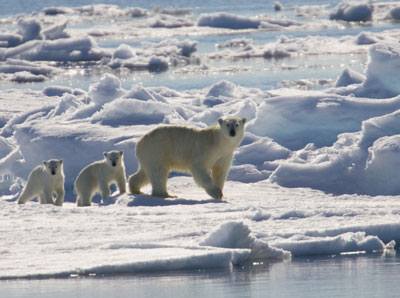 By TreeLiving
By TreeLiving
The polar bear is one of the world’s largest land mammals, and is at the top of the arctic food chain. Males grow to a length of 7 to 9 feet and may weigh up to 1,500 pounds, while females weight about a third as much. These beautiful creatures have stunning white fur that provides camouflage in their snowy habitat, yet their skin is black to facilitate the absorption o f sunlight. Combined with a thick layer of blubber, this keeps the polar bear warm.
Polar bears have inhabited Canada, Greenland, Norway, the Russian Federation and Alaska for centuries. They were once hunted by indigenous peoples of the Arctic, who ate their meat, made clothing out of their fur, used their fat as fuel and dried their organs to use for medicinal purposes. Hunting for the fur trade increased in the 16th and 17th centuries, and by the 20th century, improved hunting and trapping techniques posed a serious threat to the population.
The hunting of polar bears is now strictly regulated and no longer threatens their survival. But today they face an even greater threat because of global warming. The increase in greenhouse gases has caused a rise in average temperatures worldwide, but its effects are particularly noticeable in the arctic, where sea ice masses are shrinking and disappearing. This affects polar bears in a number of ways:
- Polar bears do most of their hunting from the edge of sea ice, where they can catch seals as they come to the surface to breathe. Smaller and fewer ice masses mean they have a smaller area in which to hunt, which translates to greater competition for available food.
- Seals make up the majority of the polar bear’s diet. But global warming has a negative impact on their population as well. That means there is less food available for the bears even when they can find a good place to hunt.
- Less polar ice creates stronger currents in the sea in which the bears swim to travel between ice masses and forces them to have to swim for longer amounts of time than they are used to. This creates an increased danger of injury and drowning for them.
- In some areas, higher summer temperatures have eradicated sea ice during the season. Polar bears that live in these areas must stay on land for several months out of the year, where they have little or no food to eat. This leads to lower body weight, which in turn lowers reproduction rates.
- When they can’t catch seals or whales, polar bears must find other sources of food to survive. Since there aren’t many land animals of sufficient size, they often become cannibals. The more global warming damages their environment, the more frequently this will happen.
Polar bears are well adapted to their icy environment. But rapid changes in the earth’s temperature are causing changes that are detrimental to their survival. In order to save these magnificent creatures, we must work to reduce the emissions of greenhouse gases that cause global warming and support programs that protect them from extinction.

